
Asterivora exocha is a species of moth in the family Choreutidae. It was first described by Edward Meyrick in 1907 and is endemic to New Zealand. This species has only been observed in the Humboldt Ranges of Otago and inhabits subalpine native bush at elevations of around 3600 ft. Adults of this species are on the wing in December and January and have been observed flying at dusk.

Heterocrossa adreptella is a moth of the Carposinidae family. This species was long considered the New Zealand raspberry budmoth however this was a taxonomic misinterpretation of the type material used to describe this species. This error was corrected in 1988 with the New Zealand raspberry budmoth giving its own species name Heterocrossa rubophaga. H. adreptella is endemic to New Zealand and has been collected in the Wellington Botanic Garden and been observed resting on mānuka branches.
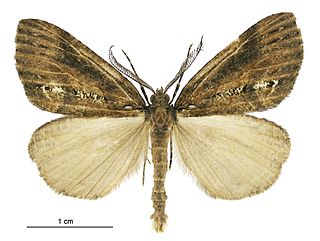
Chalastra ochrea is a moth of the family Geometridae. It is endemic to New Zealand. It has been observed in both the North and South Islands and inhabits native forest. Larvae of C. ochrea feed on the leaves of species in the genus Sophora including Sophora chathamica. Adults are on the wing from February until April. They have been collected via sugar traps.

Epiphryne undosata, also known as the lacebark looper, is a moth of the family Geometridae. It is endemic to New Zealand and is found on both the North and South Islands. It inhabits native forest. The larvae feed on plant species in the genera Hoheria and Plagianthus. They pupate amongst dead leaves in a silk cocoon. The adult moths have been observed on the wing all year round but are most commonly seen from November until February. The adult moths are extremely variable in both their colour intensity and wing pattern.

Asaphodes abrogata is a moth in the family Geometridae. It is endemic to New Zealand and can be found from the central North Island as well as the South Island. This species is inhabits open country at altitudes of between 2000 and 4000 ft. Larvae have been reared on Plantago species including Plantago coronopus. It has been recommended that Plantago raoulii be planted to attracted this species. Adults are on the wing in February and March.

Arctesthes siris is a moth of the family Geometridae. It is endemic to New Zealand and has only been found in a handful of mountainous areas in Central Otago. As at 2019 the larvae of this species has not been described but the larval hosts of this species are low growing plants in the genera Coprosma and Plantago. Adults are day flying and are on the wing from early December until mid April. This species inhabits mountainous wetland areas and snowbanks. It has been observed flying low over its preferred habitat and has been seen together with its sister species A. catapyrrha. A. siris can be distinguished from A. catapyrrha as A. siris has a noticeable concave curve in the proximal line of its forewing.

Asaphodes beata is a species of moth in the family Geometridae. It is endemic to New Zealand and is a relatively common species that can be found throughout the country in native forest or scrub habitat. It can be distinguished from its close relative Asaphodes adonis by the colour of its hind wings. The larvae of this species feeds on watercress but tends to be inactive during the day. If threatened it will mimic a twig dropping to the ground. The adult moths are on the wing from October to March and are said to be attracted to white rātā. The white markings on the forewing of the adults are variable in appearance.

Asaphodes chlamydota is a moth in the family Geometridae. It is endemic to New Zealand, and can be found in the lower part of the North Island and in the South Island. It inhabits native forest and shrublands. The larvae of this species feeds on native Clematis plants including Clematis afoliata. Adults are on the wing from November to April and are regarded as having intermedia flight powers.

Xanthorhoe orophyla is a moth of the family Geometridae. It is endemic to New Zealand and is found in the South Island in alpine habitat. This species has one brood a year and their larvae feed on cruciferous plants. Adults are on the wing from December to February and are attracted to light.

Asaphodes clarata is a species of moth in the family Geometridae. This species is endemic to New Zealand and has been found on the North and South Islands. The species inhabits open grassy areas, including tussock grasslands, in montane habitat. The larvae feed on the leaves of Ranunculus species. The adult moths are day flying and are on the wing from December to February and have been shown to pollinate Celmisia laricifolia and Hebe pinguifolia.
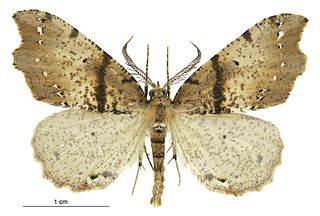
Chalastra pellurgata, also known as the brown fern moth or the pale fern looper, is a moth of the family Geometridae. This species was first described by Francis Walker in 1862. It is endemic to New Zealand and can be found throughout the country. It inhabits native forest. This species is extremely variable both in its larval and adult life stage. Larvae of this species are active during spring and summer. They feed on the fronds of fern species. C. pellurgata pupates by forming a thin cocoon on the soil amongst leaf litter and moss. Adults are on the wing throughout the year but are most common from September to March. During the day adult moths can be observed resting on dead fern fronds. They become active from dusk and are attracted to light.
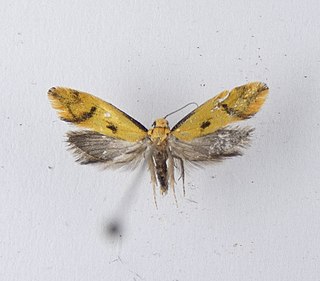
Tingena actinias is a species of moth in the family Oecophoridae. It is endemic to New Zealand and is found on the North and South Islands. The larvae of this species are leaf litter feeders. The preferred habitat of this species is shrubland and it has also been observed in gumland heaths and in beech forest.

Asaphodes nephelias is a moth in the family Geometridae. It is endemic to New Zealand and has been observed in the South Island. The preferred habitat of this species is alpine tussock grasslands above native forest and in wetlands. The adults of this species are on the wing from January to March and are day flying. The female has brachypterous wings.
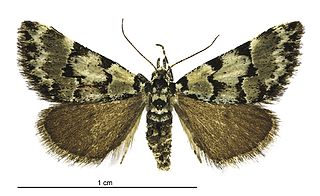
Dichromodes gypsotis is a moth of the family Geometridae. This species was described by Edward Meyrick in 1888. It is endemic to New Zealand and is found in the lower half of the South Island. The species inhabits open rocky sites. The larvae of D. gypsotis feed on lichen. The adults are day flying and are on the wing from October to January.

Helastia triphragma, also known as the angle carpet moth, is a moth of the family Geometridae. It was first described by Edward Meyrick in 1883 and originally named Cidaria triphragma. This species is endemic to New Zealand and is only found in the South Island. It inhabits native scrub in coastal, lowland and montane areas. The larval host plant of this species is Helichrysum lanceolatum. Adults are nocturnal and attracted to light.
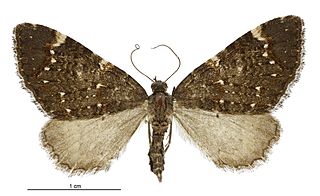
Hydriomena arida, also known as the Gunnera carpet moth, is a species of moth in the family Geometridae. It was first described by Arthur Gardiner Butler in 1879. This species is endemic to New Zealand. It is found in both the South and Stewart Islands where it inhabits native forest. It has been observed at up to 3000 ft. Larvae feed on Gunnera monoica. Adults of this species are on the wing from December until February and are nocturnal and attracted to light. This species is regarded as being uncommon.
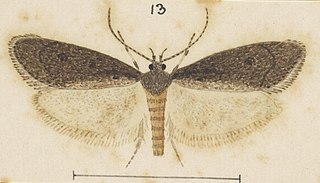
Atomotricha ommatias is a moth in the family Oecophoridae first described by Edward Meyrick in 1883. It is endemic to New Zealand and has been observed in the South Island. This species inhabits shrubland. The adults are out in the spring months of August and September and are attracted to sugar traps. The female of the species os brachypterous and is incapable of flight. Both the male and female of the species have been observed resting on fences during cold nights. The female, if touched, will hop two or three inches.

Atomotricha sordida is a moth in the family Oecophoridae first described by Arthur Gardiner Butler in 1877. It is endemic to New Zealand and has been observed in the South Island in the Canterbury and Otago regions. The adult female of the species is brachypterous.
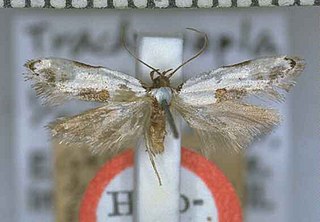
Trachypepla hieropis is a moth of the family Oecophoridae first described by Edward Meyrick in 1892. It is endemic to New Zealand and has been collected in both the North and South Islands. This species inhabits native forest and the larvae feed on leaf litter. Adults are on the wing in December and are attracted to light.

Scythris epistrota is a species of moth in the family Scythrididae first described by Edward Meyrick in 1889. It is endemic to New Zealand and has been observed in the South Island. The larvae have been found on species of New Zealand broom and they pupate within an irregularly shaped, dense, silken cocoon. Adults are day flying and are on the wing from November until February.
























